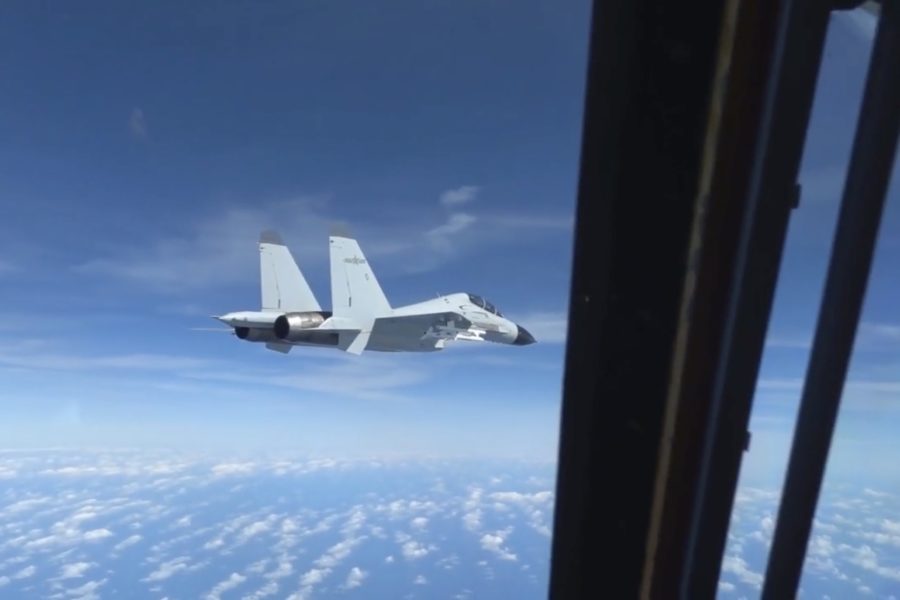The American and Chinese militaries are trading blame after a close call between two warplanes over the South China Sea on Dec. 21, as a Chinese fighter jet came within a few yards of a U.S. Air Force RC-135 Rivet Joint over the South China Sea, according to the U.S.
On Dec. 29, U.S. Indo-Pacific Command (INDOPACOM) released a statement that alleged a Chinese People’s Liberation Army-Navy (PLAN) J-11 fighter “performed an unsafe maneuver” and came within 20 feet of the American reconnaissance plane.
INDOPACOM said the U.S. aircraft was “lawfully conducting routine operations” in international airspace over the South China Sea at the time of the incident.
“The PLAN pilot flew an unsafe maneuver by flying in front of and within 20 feet of the nose of the RC-135, forcing the RC-135 to take evasive maneuvers to avoid a collision,” U.S. Indo-Pacific Command said in a statement.
The Pentagon later released a video of the incident.
A PLA spokesperson said the incident occurred near the Paracel Islands, which China calls the Xisha Islands. The U.S. did not specify where the incident took place or provide details of the plane’s flight path. The PLA reportedly claimed the RC-135 altered its flight and veered toward the Chinese fighter.
On Dec. 31, the PLA released a short video shot from the J-11, which can be seen closing in on the slower, less maneuverable RC-135.
The Chinese video, which the Pentagon has not commented on, shows the fighter jet flying alongside and then in front of the RC-135V Rivet Joint, tail code 64-842.
The Rivet Joint carries a mission flight crew of 21 to 27 people, according to the Air Force, and is used for signals intelligence. The planes are based at Offutt Air Force Base, Neb., but are often forward deployed. The J-11 is a Chinese-made fighter derived from the Russian Sukhoi Su-27.
China claims most of the South China Sea as its own and has built up militarized islands in the region, but its claims are disputed by many of its neighbors. The U.S. has entered what China claims as its airspace before, claiming it is conducting lawful, safe activities. U.S. warships also sail so-called “freedom of navigation” missions near China, including through the Taiwan Strait that separates the self-governing democratic island of Taiwan from the mainland.
After a visit to Taiwan this past summer by then-Speaker of the House Nancy Pelosi, China has increased the number of aircraft and warships crossing over the median line between Taiwan and the mainland. China has also intercepted Canadian and Australian aircraft operating near China.
In late December, the Chinese aircraft carrier Liaoning operated for two weeks in the Western Pacific. Japan said it had to scramble fighter jets to monitor Chinese activities.
“We’ve seen a sharp increase in the number of dangerous PLA intercepts of U.S. and allied forces—including Canadian aircraft—that were operating lawfully in international airspace over the South and East China Seas,” Secretary of Defense Lloyd J. Austin III said in a Nov. 19 speech in Halifax, Nova Scotia.
During a meeting a few days later with Wei Fenghe, China’s Minister of National Defense, Austin “raised concerns about the increasingly dangerous behavior demonstrated by PLA aircraft in the Indo-Pacific region that increases the risk of an accident,” according to a readout of the meeting from Pentagon spokesperson Brig. Gen. Patrick S. Ryder.
In 2015, a similar incident took place involving an RC-135 and two Chinese JH-7 aircraft, though officials said at the time there was no imminent threat of a collision.
U.S. Indo-Pacific Command and the Pentagon did not immediately reply to a request for comment regarding China’s characterization of this latest incident or provide details on what steps might be taken in response to the Chinese intercept.
INDOPACOM said in its statement the U.S. “will continue to fly, sail and operate at sea and in international airspace with due regard for the safety of all vessels and aircraft under international law.”
“We are focused on how we can manage this broad bilateral relationship—arguably the most consequential bilateral relationship in the world—constructively and responsibility,” State Department spokesperson Ned Price said Jan. 3 in response to questions about America’s relationship with China.
